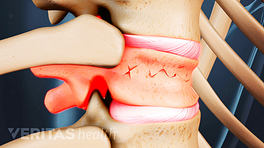Some patients with osteoporosis experience multiple vertebral compression fractures, or successive crush fractures (when the entire vertebra breaks, instead of just the front part).
See Signs and Complications of Osteoporosis
In fact, once one vertebral compression fracture has occurred, the risk of subsequent fractures is substantially higher. This condition can lead to height loss and increased thoracic kyphosis (hunching forward at the upper back) and development of dowager's hump.
See What You Need to Know About Osteoporosis
Symptoms of multiple fractures in the spine may include one or a combination of the following:
- Height loss. As the vertebrae cave in, each vertebra tends to lose at least 15-20% of its height. Thus, with successive fractures, the individual may lose a noticeable amount of height. This loss of stature changes the musculature in the back and can cause pain from muscle fatigue that can continue after the bone fracture has healed.
- Thoracic kyphosis (dowager’s hump, or hunched back). The fracture usually occurs in the front of the vertebra and leaves the height at the back of the vertebra unchanged, resulting in a wedge-shaped bone in the spine. With multiple vertebral fractures, as the front of the collapsed vertebrae fuse together, the spine bends forward, causing a kyphotic deformity and hunched over appearance.
- Bulging abdomen. As the vertebral fractures cause the patient's spine to shrink in height, his or her abdominal contents are compressed into less vertical space. As a result, the abdomen can bulge out, causing clothes not to fit properly and an appearance of gaining weight, even though the patient has not put on weight.
- Hip pain. Patients with multiple vertebral compression fractures may complain about discomfort or pain in their hips, especially the top of the hip bone. This occurs because, due to the shortened spine, the bottom of the patient's rib cage may rub against the top of the patient's hip bones (iliac crests).
- Gastrointestinal complaints. The shortened spinal column may also compress the stomach, causing weight loss (because the patient feels full after eating small amounts), constipation, or other problems.
- Neck pain. Patients with severe thoracic kyphosis may be so far hunched forward that they have to extend their necks in order to look forward, which can result in neck pain.
In general, crowding of internal organs can be a serious side effect of multiple compression fractures. For example, in severe cases, the trunk of the body may be so compressed that lung function is compromised.
Because of the extensive side effects of multiple compression fractures, it is important for patients to get an accurate diagnosis of a compression fracture caused by osteoporosis, and to treat the underlying osteoporosis in order to help prevent future fractures.








